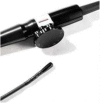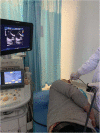The feasibility study of transnasopharyngeal esophagus echocardiography in the ultrasonic diagnosis
- PMID: 30823923
- PMCID: PMC6397502
- DOI: 10.1186/s12947-019-0154-2
The feasibility study of transnasopharyngeal esophagus echocardiography in the ultrasonic diagnosis
Abstract
Background: Professor Xinfang Wang first introduced the clinical application of trans nose pharynx esophagus echocardiography (TNPEE) in 2014. Subsequently, we developed the technology. In the present study we assess the feasibility of TNPEE in the ultrasonic diagnosis.
Methods: Select patients suitable for TNPEE examination. After obtaining written consent of patients or their families, oral dacronin hydrochloride gel local anesthesia was given 10-15 min before examination. The nostrils were disinfected and then smeared with tetracaine hydrochloride gel, which acted as local anesthesia and lubrication. The probe was inserted gently through the nostrils and entered the esophagus through the nasal cavity and pharynx. TNPEE is similar to transoral esophagus echocardiography (TOEE) after the probe reaches the esophagus.
Results: TNPEE was performed in 103 patients. Forty-five patients (43.7%) underwent the examination successfully, 46 patients (44.7%) failed because of objective reasons, 12 patients midway refused to accept the examination and cancelled the examination, accounting for 11.6%, 11 patients (12.1%) suffered from epistaxis. Of all the patients with epistaxis, 9 had taken anticoagulant drugs, accounting for 82% of the patients with epistaxis. The vital signs of all patients were stable and no serious complications occurred.
Conclusion: Compared with TOEE, TNPEE can cause less nausea and vomiting reaction, and patients take longer time to undergo examination, which is conducive to more detailed examination. However, TNPEE has a high requirement for the probe, and its success rate is relatively low. It is easy to cause nasal bleeding in patients, so its wide clinical application is limited.
Keywords: Trans nose pharynx esophagus echocardiography (TNPEE); Trans oral and esophageal echocardiography (TOEE).
Conflict of interest statement
Ethics approval and consent to participate
This study was approved by the Committee of the Ethics Committee of the Second Hospital of Lanzhou University.
Consent for publication
Not applicable
Competing interests
The authors declare that they have no competing interests.
Publisher’s Note
Springer Nature remains neutral with regard to jurisdictional claims in published maps and institutional affiliations.
Figures
Similar articles
-
Transnasal transesophageal echocardiography: a modified application mode for cardiac examination in ventilated patients.Anesth Analg. 1999 Feb;88(2):306-11. doi: 10.1097/00000539-199902000-00015. Anesth Analg. 1999. PMID: 9972746
-
Research and application of transnasal transesophageal echocardiography probe.J Huazhong Univ Sci Technolog Med Sci. 2017 Oct;37(5):782-786. doi: 10.1007/s11596-017-1805-x. Epub 2017 Oct 20. J Huazhong Univ Sci Technolog Med Sci. 2017. PMID: 29058296
-
[Transesophageal echocardiography: principles, technique and potential indications in veterinary medicine].Schweiz Arch Tierheilkd. 2004 Jul;146(7):321-6. doi: 10.1024/0036-7281.146.7.321. Schweiz Arch Tierheilkd. 2004. PMID: 15323406 Review. French.
-
Intraoperative two-dimensional echocardiography and color flow Doppler imaging: a basic transesophageal single plane patient examination sequence.Yale J Biol Med. 1993 Sep-Oct;66(5):349-83. Yale J Biol Med. 1993. PMID: 7825339 Free PMC article. Review.
-
Three-dimensional color Doppler transesophageal echocardiography for mitral paravalvular leak quantification and evaluation of percutaneous closure success.J Am Soc Echocardiogr. 2014 Nov;27(11):1153-63. doi: 10.1016/j.echo.2014.08.019. Epub 2014 Sep 26. J Am Soc Echocardiogr. 2014. PMID: 25260434
References
-
- Kihara C, Murata K, Wada Y, et al. Impact of intraoperative transesophageal echocardiography in cardiac and thoracic aortic surgery: experience in 1011 cases. Cardiol. 2009;54(2):282–288. - PubMed
-
- Stec S, Zaborska B, Sikora-Frac M, et al. First experience with microprobe transoesophageal echocardiography in non-sedated adults undergoing atrial fibrillation ablation: feasibility study and comparison with intracardiac echocardiography. Europace. 2011;13(1):51–56. doi: 10.1093/europace/euq349. - DOI - PubMed
-
- Jiménez Brítez G, Sanchis L, Regueiro A, et al. Minimally-invasive transesophageal echocardiography for left atrial appendage occlusion with a latest-generation microprobe. Initial Experience. Rev Esp Cardiol (Engl Ed). 2018. - PubMed
MeSH terms
LinkOut - more resources
Full Text Sources
Medical



